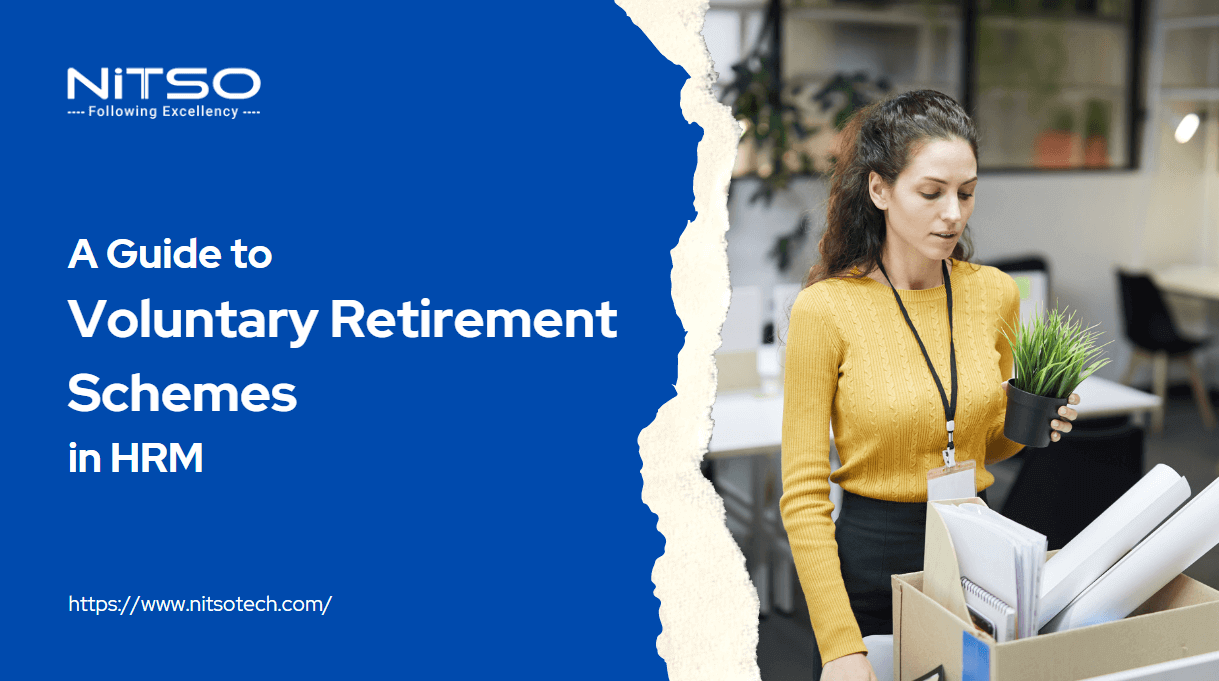One of the Indian employment’s significant features is the Voluntary Retirement Scheme (VRS), helping businesses with workforce restructuring by offering desirable retirement incentives to employees. This article aims to cover VRS’s fundamental concept and calculation process alongside highlighting its benefits and how HRM implements it.
Table of Contents
What is the Voluntary Retirement Scheme?
Employees of various organizations are provided with an opportunity to opt for voluntary retirement or separation through different programs like The Voluntary Separation Scheme(VSS), Voluntary Retirement Program(VRP), or by far the most common- The Voluntary Retirement scheme(VRS). It is typically implemented to reduce the workforce or streamline operations.
The company offers eligible employees the chance to participate in a Voluntary Retirement Scheme which allows them to retire early or resign from their positions. They will be given certain voluntary retirement benefits and incentives in exchange for their decision like lump sum payments, severance packages, extended medical coverage, pension enhancements, or other financial rewards.
One of the main goals of implementing a voluntary retirement scheme (VRS) is to attain cost effectiveness by diminishing the number of employees. This strategy is especially helpful in situations where a company encounters financial difficulties and requires operation restructuring. Through offering VRS organizations aim to avoid contentious layoffs or involuntary terminations which can adversely affect worker morale.
It’s important to note that the specific terms and conditions of a Voluntary Retirement Scheme can vary from one organization to another. The eligibility criteria, benefits offered, and the overall implementation of the VRS is determined by the company’s management or as agreed upon through negotiations with employee unions or representative bodies, where applicable.
How to Calculate Voluntary Retirement Scheme in India?
A voluntary retirement scheme (VRS) is available to eligible Indian employees looking forward to retiring ahead of time. Calculating VRS payment involves taking into account numerous variables like age at retirement plus duration served at the organization. Other relevant things like base pay during the working period plus any additional benefits from the company’s side. To aid you in understanding the whole process better, we have provided a step-by-step breakdown of how voluntary retirement scheme calculation works.
Determine the eligibility criteria
Employees who are interested in the organization’s voluntary retirement program must meet certain eligibility requirements. These criteria are established by the company and include a minimum year of service and a specific age threshold.
Calculate the number of eligible years of service
Determine the total number of years an employee has served in the organization. This is typically calculated from the date of joining until the date of voluntary retirement.
Determine the salary components
Identify the components of the employee’s salary that will be considered for calculating the voluntary retirement benefits. This usually includes the basic salary, dearness allowance (if applicable), and any other fixed salary components.
Calculate the compensation amount
A specific formula is implemented to determine the sum of voluntary retirement compensation, in which aspects such as years of employment and salary components factor in. Though several formulas can be utilized, but a commonly used formula is:
Compensation = (Number of years of service x Salary component) + (Number of years of service x Salary component x Gratuity factor) + (Number of years of service x Salary component x Leave encashment factor)
- The “Gratuity factor” is a percentage (typically 15 or 30) used to calculate the gratuity amount based on the years of service.
- The “Leave encashment factor” is commonly calculated as a percentage that typically corresponds to the number of unused leaves when computing the total leave encashment value.
Add any additional benefits
The VRS entails more than just a compensation amount. It may also present supplementary perks like medical coverage, pension enhancements, or lump-sum payments. These add-ons ought to be factored in when computing the whole compensation.
Tax implications
It’s important to consider the tax implications of the VRS package, as certain components may be taxable while others may be exempted up to a certain limit. Consultation with a tax expert or accountant is advisable to ensure compliance with applicable tax laws.
Example:
Let’s consider an example to illustrate the calculation of voluntary retirement schemes in India:
Employee details:
- Number of years of service: 20 years
- Basic salary: Rs. 50,000 per month
- Gratuity factor: 15 (15% of basic salary)
- Leave encashment factor: 10 (10% of basic salary)
Calculation: Compensation = (20 years x Rs. 50,000) + (20 years x Rs. 50,000 x 15%) + (20 years x Rs. 50,000 x 10%)
Compensation = Rs. 10,00,000 + Rs. 15,00,000 + Rs. 10,00,000 = Rs. 35,00,000
In this example, the employee would be entitled to a compensation amount of Rs. 35,00,000 under the VRS.
It’s important to note that actual calculations and benefits can vary depending on an organization’s policies, VRS terms, and applicable laws. Therefore, it is highly suggested to connect with the HR department or appropriate authorities in your company to obtain precise and current guidance personalized exclusively for your circumstances.
What are the Benefits of the Voluntary Retirement Scheme?
In this scheme, an employee decides if they would retire early and receive related perks such as severance pay. Factors like organizational policies or regulatory requirements may influence decision making when it comes to identifying particular benefits available under VRS. Here are some common benefits that may be provided under a VRS:
- Lump-sum compensation: In recognition of their decision to opt for voluntary retirement, eligible employees may receive a lump sum payment as compensation. This particular payout is typically determined by evaluating variables such as length of service, salary structure and other applicable factors in conjunction with the employees unique circumstances.
- Severance pay: Besides the one time payment given to employees they could be eligible for severance pay. This type of financial aid is meant to assist them with moving forward into their next phase of life or career phase.
- Gratuity: Gratuity is a statutory benefit in India, and employees who qualify for VRS may receive an enhanced gratuity amount based on their years of service. The gratuity amount is calculated using a formula specified under the Payment of Gratuity Act.
- Pension enhancements: If the organization provides a pension scheme, employees opting for VRS may receive enhancements to their pension benefits. This could include an increase in the pension amount or adjustments in the calculation of pension based on years of service.
- Leave encashment: Employees may be allowed to encash their unused leave balance, meaning they receive a monetary payout for the accrued but unused leave days.
- Medical benefits: Depending on the organization’s policies, employees opting for VRS may continue to receive medical benefits for themselves and their dependents, either for a specific period or throughout their lifetime.
- Retraining and outplacement assistance: Some organizations may offer retraining programs or outplacement assistance to help employees transition into new careers or find employment opportunities outside the organization. This can include career counseling, job placement support, or employee skill development programs.
It should be noted that precise advantages and specifics related to VRS can differ across organizations. Thusly, it is advisable for employees who are assessing whether or not they want to opt for this scheme to diligently consider all aspects involved in it. The first step towards achieving this goal would involve analyzing all the details mentioned about VRS offered by one’s employer followed by conversations with their HR department. Furthermore, making use of professional guidance will provide a deeper clarity about what one might be eligible for under said scheme.
How to Implement the Voluntary Retirement Scheme in HRM?
Implementing a Voluntary Retirement Scheme in HRM (Human Resource Management) involves several steps to ensure a smooth and fair process for employees who opt for voluntary retirement. Here’s a general guideline for implementing a VRS:
- Policy development: Develop a comprehensive VRS policy that outlines the objectives, eligibility criteria, benefits, and other relevant details of the scheme. This policy should be aligned with legal requirements, company goals, and industry norms.
- Communication and awareness: Communicate the VRS policy to all employees clearly and transparently. Provide information sessions, written materials, and opportunities for employees to ask questions and seek clarification. It’s crucial to maintain confidentiality and address any concerns employees may have.
- Eligibility criteria: Define the eligibility criteria for employees to qualify for the VRS. This may include factors such as age, years of service, or other specific requirements. Ensure that the criteria are fair, non-discriminatory, and in compliance with legal regulations.
- Application process: Establish a process for employees to submit their voluntary retirement applications. Set a deadline for applications and provide a designated point of contact for employees to seek guidance or assistance throughout the application process.
- Evaluation and selection: Establish a fair and objective evaluation process to review and assess the VRS applications. Consider factors such as the organization’s requirements, seniority, skills, and any other relevant criteria. Ensure transparency and maintain records of the evaluation process.
- Calculation of benefits: Develop a systematic method to calculate the benefits under the VRS based on predefined formulas and criteria. Consider factors such as years of service, salary components, gratuity, leave encashment, and other applicable benefits. Seek guidance from legal and financial experts to ensure compliance with relevant laws and regulations.
- Individual consultations: Conduct individual consultations with employees who have applied for VRS. Provide them with a clear understanding of the benefits they will receive, the implications of the decision, and any other relevant information. Allow employees to ask questions and seek further clarification.
- Documentation and agreements: Prepare the necessary documentation, including voluntary retirement agreements, acceptance letters, and any other required legal documents. Ensure that employees fully understand the terms and conditions of the VRS and provide them with copies of all relevant documents.
- Transition support: Provide support and resources to employees who opt for voluntary retirement. This can include assistance with financial planning, career transition programs, retraining opportunities, and access to counseling or other support services.
- Recordkeeping and compliance: Maintain accurate records of the VRS process, including applications, evaluations, calculations, and agreements. Ensure compliance with legal requirements, including tax regulations, labor laws, and employee benefits regulations.
- Post-VRS evaluation: Evaluate the outcomes of the VRS implementation, including the impact on the organization, remaining workforce, and overall objectives. Assess the effectiveness of the scheme and identify areas for improvement in future implementations.
When implementing the Voluntary Retirement Scheme, it’s crucial to remember that each organization’s requirements and legal regulations vary. Seeking guidance from HR professionals, legal experts, and relevant stakeholders could prove advantageous during the implementation of the Voluntary Retirement Scheme.
Finale Thought on VRS
In conclusion, the Voluntary Retirement Scheme (VRS) serves as a valuable tool in human resource management for organizations seeking to streamline operations, reduce costs, and offer an amicable exit option for eligible employees. The successful implementation of a VRS requires careful planning, clear communication, and adherence to legal and ethical considerations.
By developing a well-defined VRS policy, organizations can establish eligibility criteria, outline benefits, and ensure fairness throughout the process. Transparent communication and awareness campaigns play a crucial role in disseminating information and addressing employee concerns.
The calculation of VRS benefits, taking into account factors such as years of service, salary components, gratuity, leave encashment, and other applicable benefits, requires careful consideration and may necessitate consultation with experts in finance and law.
Individual consultations with employees who apply for VRS provide a forum for addressing questions and clarifying the implications of their decision. Additionally, providing support services, such as financial planning assistance and career transition programs, can help employees navigate the post-retirement phase.
Maintaining comprehensive records and ensuring compliance with legal requirements are critical aspects of implementing a VRS. Regular evaluation of the scheme’s outcomes allows organizations to assess its effectiveness and make improvements for future implementations.
In summary, a well-executed VRS can benefit both organizations and employees by enabling a smooth transition, minimizing the need for involuntary layoffs, and providing financial and support benefits to those who voluntarily choose retirement. Properly implemented, the VRS contributes to a positive work environment and strengthens the employer-employee relationship.
FAQs Related to VRS
Is there a pension scheme in the Voluntary Retirement Scheme?
The inclusion of a pension scheme in the Voluntary Retirement Scheme (VRS) depends on the policies and regulations of the organization implementing the scheme. Some organizations may offer a pension as part of the VRS package, providing a steady income stream to retired employees. However, it is important to note that not all VRS schemes guarantee a pension. Employees should carefully review the terms and conditions of the specific VRS offered by their organization to understand the pension provisions, if any.
Who is eligible for VRS?
Eligibility criteria for the Voluntary Retirement Scheme (VRS) may vary across organizations, but typically, employees meeting the following criteria are eligible:
1. Employees who have completed a certain minimum number of years of service, such as 10 years or more.
2. Employees who have reached a certain age, are often referred to as the “voluntary retirement age,” which is usually between 40 and 58 years.
It is important to note that differences in specific eligibility criteria may arise due to variations in organizational protocols and the VRS model being implemented.
What is the Voluntary Retirement Scheme for central government employees?
The Voluntary Retirement Scheme is available to Indian Central Government employees working across different departments and agencies in India. Employees meeting specific requirements or perquisites can opt-in for early retirement through this scheme voluntarily. The Central Government prepares guidelines, creates structures that offer specific benefits tailored to its employee’s needs under VRS.
What is the Voluntary Retirement Scheme for state government employees?
Similar to the Voluntary Retirement Scheme for central government employees, the Voluntary Retirement Scheme for state government employees is designed for employees working within the state government administrations across different states in India. The scheme offers eligible employees the option to voluntarily retire, often with certain benefits and provisions. The specific guidelines, eligibility criteria, and benefits under the VRS may vary from state to state.
What is the Voluntary Retirement Scheme for bank employees?
The Voluntary Retirement Scheme for bank employees pertains to the banking sector in India. It offers eligible employees in banks the opportunity to voluntarily retire from their positions, usually after fulfilling specific service and age criteria. The scheme aims to streamline operations, optimize workforce efficiency, and provide retirement benefits to employees who choose to retire voluntarily. Each bank may have its own VRS framework, with distinct guidelines and benefits tailored to their organization.
What is the link to the Voluntary Retirement Scheme PDF?
The availability of a VRS-related PDF document may differ depending on who is overseeing the scheme. To retrieve appropriate information and authoritative guidelines, it is advisable to browse the official website of your relevant organization, government department, or regulatory body that manages VRS. These online platforms generally comprise extensive documents, which incorporate PDFs and explain all aspects of the scheme such as eligibility requirements, calculation methods, and benefits. For example, the voluntary retirement scheme PDF for the Department of Public Enterprises can be found at https://dpe.gov.in/dpe-guidelines/voluntary-retirement-scheme-(vrs).
What is the Special Female Voluntary Retirement Scheme Unity 2014?
The Special Female Voluntary Retirement Scheme Unity 2014 is a specific voluntary retirement scheme introduced in 2014 with the objective of facilitating the voluntary retirement of female employees. It is designed to address the unique needs and circumstances of women in the workforce. The scheme may offer certain additional benefits or provisions specifically tailored for female employees who opt for voluntary retirement.
What is the maximum limit for the Voluntary Retirement Scheme?
It’s worth noting that each organization enacting Voluntary Retirement Scheme (VRS) develops unique policies and regulations regarding its parameters – including the all-important max limit. Mostly, this varies on either how long one has been employed or their current age. For instance, businesses using demographic limitations commonly restrict eligibility once you reach age 58. Alternately, others use tenure: every year with a company counts towards an ultimate total beyond which you aren’t eligible even if younger than said cut-off date – typically between 25-30 years completed service time-wise.
At what age can VRS be taken?
When entertaining its employees’ eligibility for Voluntary Retirement Scheme (VRS), organizations generally lay down varying policies with different “voluntary retirement ages.” This lower and upper limit ranges between 40 to 58 years. Once potential employee crosses their respective voluntary retirement age threshold, they have the option to seek VRS from their employers.
Will I get a pension if I take voluntary retirement?
The provision of a pension upon taking voluntary retirement depends on the organization’s policies and the specific terms of the Voluntary Retirement Scheme (VRS). Some VRS schemes may include a pension component, ensuring a regular income stream for retired employees. However, it is important to note that not all VRS schemes guarantee a pension. Employees should carefully review the terms and conditions of the specific VRS offered by their organization to understand the pension provisions, if any.
What is the difference between VRS and resignation?
The main difference between the Voluntary Retirement Scheme (VRS) and resignation lie in the circumstances and benefits associated with each.
VRS: VRS is a scheme offered by organizations that allows eligible employees to voluntarily retire from their positions. It typically provides certain benefits and incentives to employees who choose this option, such as financial compensation, retirement benefits, and healthcare facilities.
Resignation: Resignation, on the other hand, refers to an employee’s voluntary decision to terminate their employment contract and leave the organization. Unlike VRS, resignation may not come with specific benefits or incentives unless provided for in the organization’s policies or employment agreement.
Can the Voluntary Retirement Scheme be rejected?
Participation in a Voluntary Retirement Scheme (VRS) consists of accepting policies from specific organizations offering this option. It’s essential to note that every company implements its own policies and directives concerning schemes like these-based on operational requirements, workforce planning or financial constraints among other reasons. Although companies have this choice when receiving applications from employees for voluntary retirement schemes under VRS, provided the employee meets the eligibility criteria and other conditions specified by the organization.
Can I take the Voluntary Retirement Scheme after 5 years?
Organizations differ in their eligibility criteria for the Voluntary Retirement Scheme (VRS) with requirements for minimum years of service varying as well. Some may require 10 or more years while others might have a shorter timeframe such as 5 years. It is crucial to refer to the policies and guidelines of the organization offering the VRS to determine if you meet the minimum service requirement for eligibility.
Article you might be intrested in: Maximizing Asset Management Efficiency
Article you might be intrested in: Maximizing Productivity with Employee Screen Monitoring Software








Hello, I enjoy reading through your article. I like to write a little comment to support you.
Hi there! Someone in my Myspace group shared this
website with us so I came to give it a look. I’m definitely loving
the information. I’m bookmarking and will be tweeting this to my followers!
Exceptional blog and amazing style and design.
I was recommended this web site by my cousin. I’m not sure whether this post is
written by him as no one else know such detailed about
my difficulty. You are amazing! Thanks!
Terrific article! This is the kind of information that
are meant to be shared around the internet. Disgrace on the seek engines for now
not positioning this post upper! Come on over and
seek advice from my website . Thank you =)
Hello to all, how is the whole thing, I think every one is getting more from this web
page, and your views are pleasant for new people.